Ah, this is easy: You should walk your dog for as long as it takes him to poop, pee and obtain enough exercise. Next question.
If only it were that simple…
Everyone knows that dogs of all ages need adequate exercise, but it is often difficult to define this in concrete terms. Determining the proper level of exercise requires the careful consideration of a variety of factors, including your dog’s age, size, breed and health status.
The Benefits of Frequent Dog Walks: Why Your Dog Needs to Be Walked!
Walking your dog provides him with a slew of health benefits (many of which, you will surely enjoy as well – let’s not forget that few humans get enough exercise themselves). Some of the most important ones include:
- Exercise – Moving around and challenging your pup’s muscles helps to keep him in good shape and healthy.
- Weight Control – Walks help your dog to burn off excess calories, which can help keep him trim. Obesity is a common problem among dogs, which can lead to a host of serious illnesses, including diabetes and joint disorders.
- Reducing Mischievous Behaviors – Walks help to tire out your pooch and burn off excess energy, which will usually reduce the prevalence of undesirable behaviors. As they say, “A tired dog is a good dog.” The number one solution to most dog behavioral problems is simply getting your dog more exercise!
- Bonding Time – Walks give you a chance to hang out with your dog and reinforce your bond. This is good for both you and your pup! In fact, recent dog walking statistics have shown that owners who regularly walk their dogs tend to have a closer bond than those who don’t regularly walk their pups.
- Mental Stimulation – By getting out of the house and letting your dog smell the roses (or whatever else he wants to sniff), you provide mental stimulation. This is important for your dog’s well-being and quality of life. Dogs can’t stand being cooped up inside all day – they want to be out exploring the great outdoors!
- Behavioral Reinforcement – You can use walks as part of your typical training work, teaching your dog to heel and walk politely on a leash. This is not only helpful for training your dog to be well-behaved and obedient, but it is another form of mental stimulation.
- Socialization – You’ll likely encounter a lot of other people and dogs while going on walks, and this can provide your pup with beneficial socialization opportunities. Dogs that aren’t properly socialized are more prone to anxiety, stress, and behavioral issues that can end up being dangerous if left unchecked. Well socialized dogs are happy dogs. Just be sure that you keep your dog on a leash and use common sense when introducing him to new people and pups.
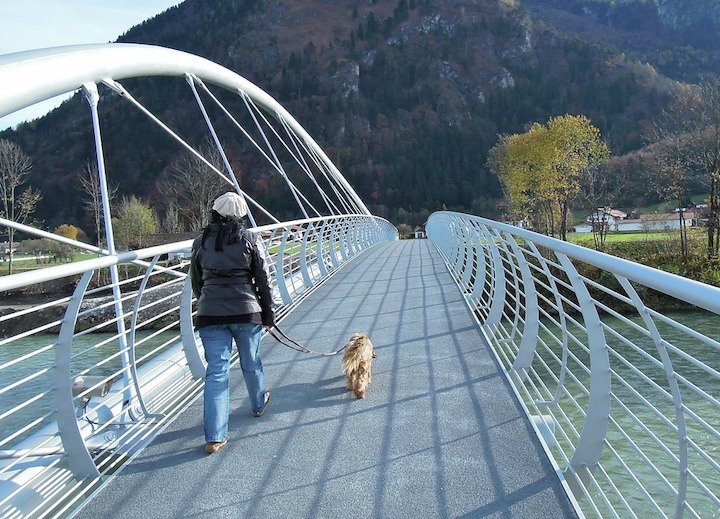
Guidelines for Walking Adult Dogs: Hitting the Long Dusty Trails
How Much Exercise Does the Average Dog Need Everyday?
Few authorities make concrete recommendations regarding exercise limits or guidelines, but those that do often recommend that healthy adult dogs get between 30 to 120 minutes of exercise each day.
Obviously walks should be a component of this, but you’ll also have to provide time for higher intensity exercise.
Ways to provide your pooch with high intensity dog exercise include:
Few people have the time or inclination to walk with their dog for an hour or more each day, so you’ll need to determine how much exercise your dog needs and deduct the amount of time you allow him to get high-octane exercise, to determine the length of time you need to walk him.
Don’t forget there are also several strategies to get your dog indoor exercise too – so even in the winter you can make sure your dog is burning off plenty of excess energy!
Your Dog’s Exercise Needs Vary Based on Breed
You’ll have to take your dog’s breed into account, among other things to determine this figure. For example, high-energy breeds – Australian cattle dogs, border collies, Labrador retrievers and others – will need about 2 hours of activity a day, and they’ll want most of this to take the form of vigorous exercise.
So, if you let your cattle dog play for about an hour at the dog park each day, you’ll need to take him on two or three 20- to 30-minute walks a day to get him enough activity.
Conversely, basset hounds, bulldogs and other low-energy breeds probably only need about 30 minutes or so of activity a day. For these dogs, a couple of 15 minute walks and a brief game of tag with their human are probably sufficient.
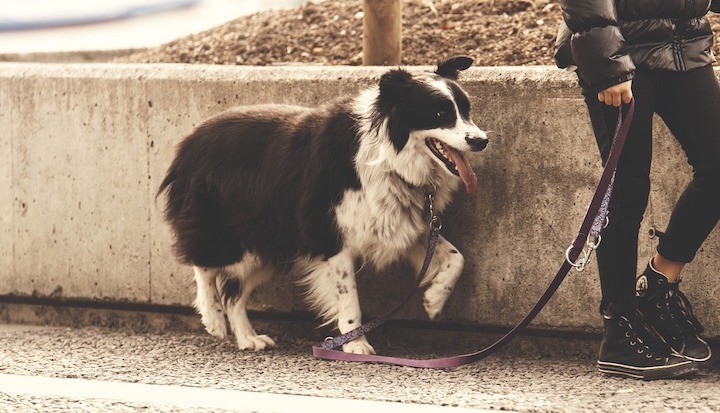
Observe your dog’s behavior as an indicator to how much exercise your canine needs. If he’s restless and pacing, he may need more exercise. Dogs that seem content lounging on the couch are probably good with a few strolls around the neighborhood and won’t need much more.
Keep in mind that while the majority of dogs love a good jog or game of fetch, snub-nosed breeds in particular shouldn’t be pushed hard, as they have respiratory issues that can become dangerous with high levels of intense exercise.
How Often Should I Walk My Dog?
The frequency of walks depends mostly on your dog’s needs and your own availability. Most owners opt for a walk in the morning before work, as well as the afternoon when work lets out. Owners of high-energy dogs might also enlist a dog walking service like Rover to ensure that their dog gets out in the middle of the afternoon as well.
Keep in mind that if you can’t let your dog out in the yard to relieve himself, your outdoor walks are also your pooch’s only method to go to the bathroom.
While most full grown adult dogs can handle holding it up to 8 hours, puppies need much more frequent trips to the bathroom. Without an easy-to-access backyard, puppies will need to go out every 1-2 hours, so you should really never bring a puppy into your home unless you can have someone at home all day to take them out frequently. Granted, these aren’t actual walks – just quick bathroom breaks, but your puppy still needs them!
Senior Dogs Will Need to Slow it Down
Don’t forget that senior dogs require less exercise than younger dogs do. Older canines still need and benefit from exercise, but their aging joints and reduced energy level will limit the amount of activity they want or need. Once your dog approaches 7 or 8 years of age (sooner for short-lived breeds), talk to your vet about how to properly adjust your aging dog’s exercise requirements and walking schedule.
For some high-energy canines, a doggy treadmill may provide some assistance in wearing out restless pooches. Just remember that dogs need to be properly introduced and trained on treadmills – it requires some effort, and not all dogs may be down for it.
Guidelines for How Long to Walk Puppies (And How Far)
Puppies need plenty of exercise and stimulation, but don’t overdo it. Excessive exercise can cause long-term health problems and damage your young pup’s growing bones. Therefore, you should always err on the side of caution when taking your puppy out for a walk.
The Kennel Club – a U.K.-based organization – recommends providing growing puppies with 5 minutes of activity-time for every month of your pup’s age. In other words, a 2-month-old puppy should be walked for about 10 minutes at a time, whereas a 10-month-old puppy can remain active for about 50 minutes, including some high-intensity activity.
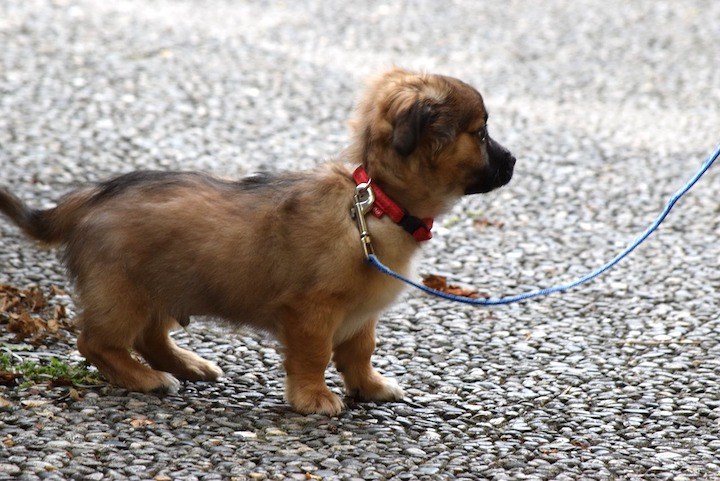
Keeping Your Dog Safe on Walks
Going on a walk with your dog is not exactly a high-risk activity – particularly if your walk only takes you through the well-manicured and often-antiseptic suburbs. But that doesn’t mean your dog can’t sustain injuries in the process. Keep the following tips in mind to ensure that your walk goes smoothly and your dog returns content and tired.
- Keep your dog on a leash. The world is full of dangers to your pooch, and it is your responsibility to protect him from things that may hurt him. Even the best-behaved dogs occasionally chase after cars or get into things that may be dangerous. A leash allows you to prevent these things from happening.
- Be mindful of your dog’s feet. This is especially important if your dog is accustomed to soft surfaces, such as grass. If you suddenly begin forcing him to walk on concrete or gravel, it is likely to cause significant damage to his pads (not to mention considerable pain). However, once accustomed to roads and sidewalks, most dogs tolerate them safely. Just be sure that you do not walk them across excessively hot surfaces, and use booties (or paw wax like Musher’s Secret) to protect his feet from snow, ice, and salt in the winter.
- Always bring water if you plan to travel far from home. No, you don’t need to grab a water bottle and bowl to walk your Yorkie around the block; but you absolutely should bring water when walking a 2-mile loop with your lab. Many modern parks feature water fountains that are accessible to dogs, but these occasionally break and are of no use in the winter. Opt for a dog-friendly water bottle on longer treks – many have self-contained covers or bowls that let you and your dog share a refreshing swig of H20.
- Always consult with your veterinarian before beginning any exercise regimen. Dogs may suffer from health problems that may be exacerbated by prolonged walks. In these cases, you may need to keep the walks short and easy, or you may need to avoid them altogether.
- Stay Visible. If you walk your dog after dusk (which will be the case for most owners at least at some point in the year) make sure you and your four-legged buddy are appropriately prepared. Deck you and your dog out in reflective vests and/or glow collars, and avoid heavy-traffic areas if possible. For more tips, read our guide on night walking with your dog!
***
The important thing to remember is that every dog will have varying needs for exercise and mental stimulation. Rather than trying to follow some arbitrary distance or length of time, monitor your dog’s health, body weight and behavior. Always start walking regimens slowly, so your dog can acclimate to the new activity before diving headfirst into a heavy-duty walking program.
Do you take your dog out for regular, long walks? Tell us all about your routine in the comments below!
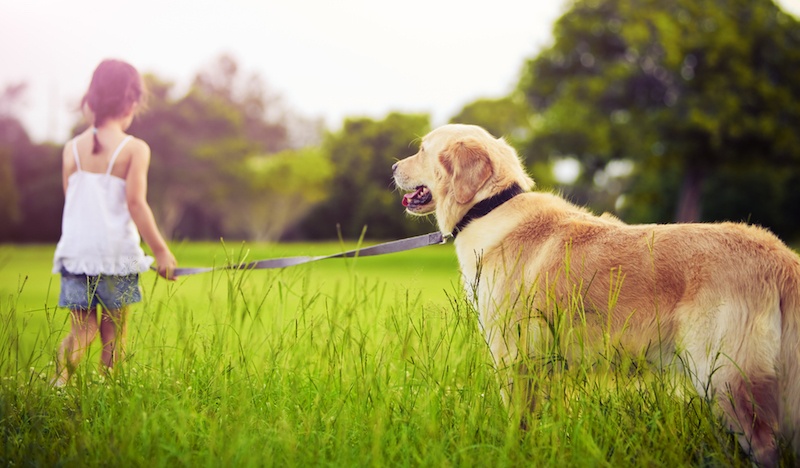




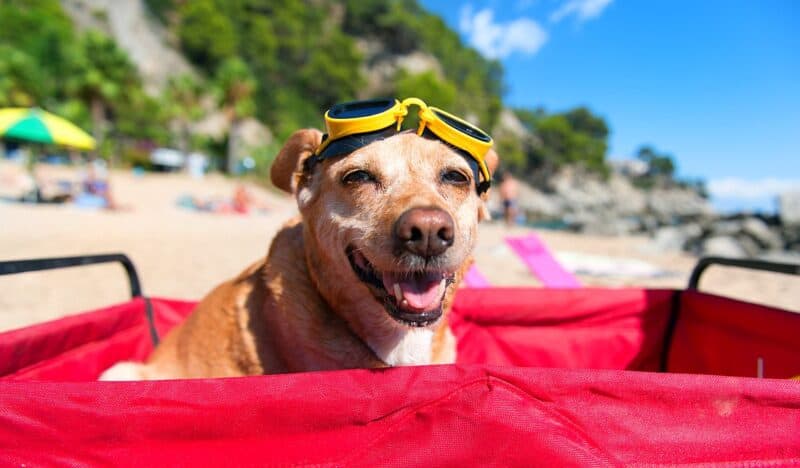


Leave a Comment